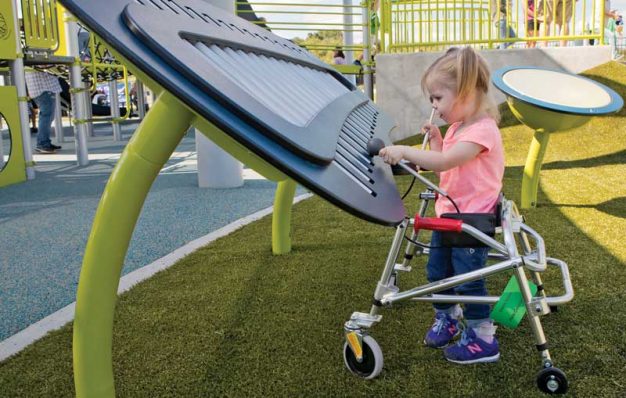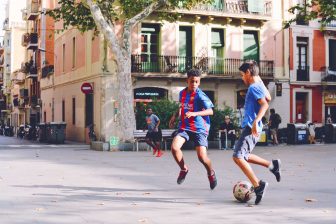
Shaped by play and inclusive play
Play has an invaluable role in encouraging child development. But play isn’t just one thing. It’s an invitation to explore, learn and grow. Play opens up a world of possibilities.
Play—on a playground, in a soccer game or at an art studio—teaches kids how to not only exist together but to accept people of all ages, abilities, and backgrounds. In other words, play helps shape kids into thinkers, dreamers, and leaders.
Life lessons
Above and beyond these life lessons, it’s on the playground that children learn persistence, leadership, competition, bravery, support, and empathy. Landscape Structures Inc., a Delano, Minn.-based commercial playground equipment manufacturer, understands this powerful reality. Play is fun, and physically beneficial, of course. But play is also an organic form of learning.
For years, the campaign for more play has revolved around battling the childhood obesity epidemic. However, play is important for more than just physical development. Play helps shape children’s cognitive, motor and social skills, in addition to supporting leadership development, teaching tolerance, spurring creativity, promoting problem-solving and diligence, and regulating emotions. Play is a learning opportunity. And that’s why it’s important to offer free play time to children of all ages and abilities.
To date, playgrounds have been largely overlooked as settings for development—perhaps because it is easy to assume that play is “just for fun” or playgrounds are just for exercise. However, research suggests children’s early experiences and the settings they inhabit play a powerful role in helping children become healthy and effective thinkers, leaders and collaborators.
Playground design
Playgrounds can be deliberately designed to encourage children’s engagement in developmentally significant forms of play. They provide space for children to blend pretense and social play with physical activity; children can run around while “fighting dragons” or swing from the play equipment like monkeys, exercising their social, cognitive and physical skills all at once.
Even more, well-designed playgrounds provide for children with diverse needs and levels of ability. Toddlers who are learning to walk can find a physical challenge in climbing a few stairs, while skillful 10-year-olds can find an equally exciting challenge in clambering to the top of a playstructure. Children can take advantage of open spaces to engage in socially and linguistically complex pretend scenarios, but also find a quiet nook in which to privately create elaborate stories.
According to Landscape Structures’ Inclusive Play Survey, more than 70 percent of parents strongly agree that playground equipment should be designed so all children can play together. That’s why the company continues to design commercial playground equipment and public play environments where children of all abilities and their families can play and learn together.
ADA guidelines
Since the development of the ADA guidelines, Landscape Structures has led the industry in creating playground designs and products that go beyond minimum requirements. The team of designers at Landscape Structures follows the Seven Principles of Universal Design to create playground designs that best fit the needs of members in the community.
Universal Design is a framework for the design of environments, products, buildings, ideas and more with the express goal that they be usable by the widest range of abilities. This framework influences the company’s Inclusive Play Design Philosophy to ultimately increase access, safety, comfort and social participation within the play environment. Using a combination of these elements allows every child to choose how they want to engage in the play space.
Inclusive playgrounds
Inclusive playgrounds provide broad play experiences, which allow children to integrate and develop all of their senses. Products like the We-Go-Round™, and Chill™ and Curva™ Spinners engage kids’ visual and vestibular systems to help them develop a better sense of balance and motor planning. Swinging on the Friendship™ Swing or moving back-and-forth on the Sway Fun® glider gives kids an understanding of how their body moves through space and the speed of movement with which they’re comfortable.
The more kids play, the more they develop the skills necessary to engage, change and impact the world around them. Climbing on playground structures like the Crab Trap™ engages many sensory systems, which teaches kids to relate to objects and navigate in the world. Play experiences that offer lots of touch opportunities, like with the Rhapsody® Outdoor Musical Instruments, are necessary to let kids organize information for developing visual and auditory systems.
Landscape Structures
Landscape Structures is on the cutting edge of developing inclusive playground components and designs, but they don’t do it alone. The company works with their Inclusive Play Advisory Board, a team of experts in the fields of child development, adaptive recreation, sensory play and occupational therapy to bring play and recreational opportunities to children and families of all abilities.
Landscape Structures has an ongoing commitment to creating new inclusive playground products, as well as designing accessible, developmentally appropriate, and sensory-stimulating community and school playgrounds. The company hopes that its continued focus will bring to light the diverse and sensory needs of all children, and that playground planners will take note and move towards creating truly inclusive playgrounds. Learn more about Landscape Structures’ inclusive playground products, design philosophy, partners and more at playlsi.com.
In order to create a playground design that ensures kids will make time for free play, it’s important to remember that play is a trial run of adulthood. A way for kids to discover and practice all the skills they’ll need in the future. It’s important to design playgrounds so that kids of all abilities can practice their leadership skills, and learn to accept people of all ages, abilities, and backgrounds.
Learn more about Landscape Structures’ commitment to shaping the lives of children through play by watching their newest video, Play Will Always Shape Us, at shapedbyplay.com. While there, you can download a video discussion guide as well as copies of research whitepapers.




